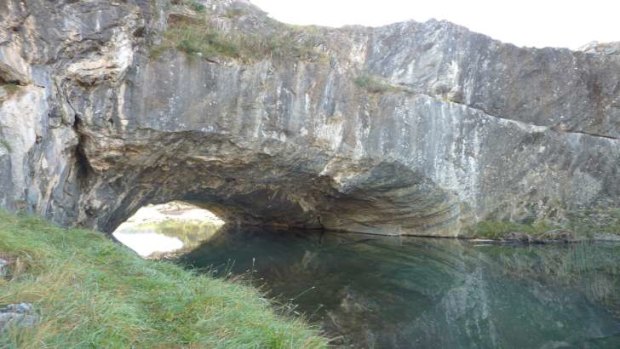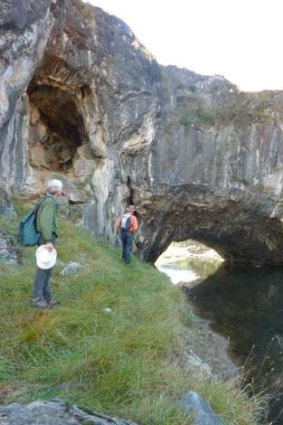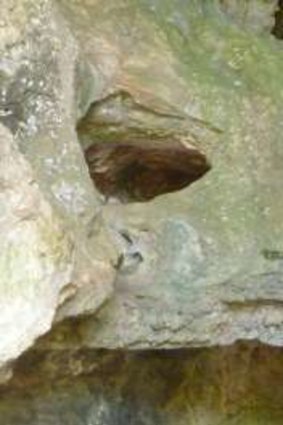
London Bridge, located just out of Canberra in the Googong Foreshores.Credit: Tim the Yowie Man
It has stood sentinel in its present form for more than 20,000 years, much longer than its manmade namesake in England has, or is ever likely to.
Spectacularly spanning the Burra Creek, on the southern foreshores of Googong Dam, the London Bridge Arch was first recorded by Europeans in 1823 by explorer Captain Mark Currie who described it as ‘‘a natural bridge of one perfect Saxon arch, under which the water passed’’.
These days, despite its accessibility – a 15-minute stroll down the London Bridge walking track – it is surprisingly seldom visited. If it were located near Lake Burley Griffin, rather than Googong Dam it would probably be a tourist mecca. That said, the lack of crowds impacting on its fragile environment is probably one reason this natural curiosity remains such a special place to visit.

Exploring London BridgeCredit: Tim the Yowie Man
The origins of the arch date back to a time 420 million years ago when limestone began to form as sediment and coral remains deposited on an ancient ocean floor. Over time the ocean receded and the arch was formed by water slowly leaching through the limestone, enlarging cracks until a passage became large enough for Burra Creek to pass through. On most days it’s hard to believe that the small trickle of water dribbling along the Burra Creek would be sufficient to carve out such an impressive hole in the limestone.
However, on a visit to the arch last week there was still a substantial amount of debris left in high in trees from last summer’s heavy rains, testimony to the fact that when it floods here, there’s an enormous amount of water forcing its way through the gap.
This amazing arch isn’t the only feature of this landscape carved by water. If you stand downstream of the arch and you look to the top left, you will see what appears to be a large indent in the rock. This is a small cave where, if you look closely, the entrance is dominated by a natural rock formation that resembles a giant serpent’s head – as if guarding this secret cavern from the prying eyes.
There is speculation that the bones were removed by locals so as to avoid collection.
And as well it might, for this small cave (which rangers advise against entering for cultural and safety reasons) has a fascinating history. In the late 1800s there were rumours that hundreds of human bones, including skulls were crammed into caves near the arch – possibly part of some local burial custom. On the discovery of the bones, by a local policeman Superintendent Brennan, in January 1874, a coroner from Queanbeyan was called to investigate. What happened next seems to have been lost in the sands of time.
There are various unsubstantiated versions of the story, including one account that suggests it took the coroner several days to arrive and by the time he did, most of the bones had vanished. There is speculation that the bones were removed by locals so as to avoid collection. Adding further intrigue to this story is that the small number of bones which were supposedly retrieved by the coroner were later buried in the Queanbeyan Pioneer Cemetery, only to have subsequently washed away in a flood. The mystery of the human bones may never be solved.
‘‘Many caves were filled in to prevent stock loss so it is a possibility that there were a few burials in caves we can’t find now,’’ explains Helen Cooke, an archaeologist involved in several digs around the arch late last century.

The rock 'serpent' that guards the entry to the cave adjacent to London Bridge.Credit: Tim the Yowie Man
Although no fragments of human bones were unearthed in the digs, the remains of locally extinct native rats, mice and small marsupials were found.
It is thought that farming in the area led to the local extinction of these critters and if you continue along the walking track for another 20 minutes or so you will reach the most significant remnant from that farming era – the London Bridge Homestead which was acquired by the Commonwealth in 1973 to protect catchment of the Googong Dam. The homestead (now secured behind a high security fence) is significant both historically and architecturally. It was made using a variety of materials and techniques over a 100-year period and looking through the fence it’s clear to see at least five architectural styles here – including original 1860s stone cottage and slab hut to more recent cement and weatherboard buildings. It’s like looking at an open air museum.
People often ask me for my best walks in the region. For its natural and man-made features and ease of accessibility this short walk has to be one of my favourites.
FACT FILE
London Bridge Walk: The 3.4km circuit starts at the London Bridge car park which is located around 20km south of Queanbeyan via the southern entrance to Googong Foreshores. A brochure and map is available at the start of the walk. For more information, call the ranger station on 6207 2779 or check out www.tams.gov.au
Did you know? Googong Foreshores is day use only and gates open at 8am and close at 5pm. Allow plenty of time for your walk so as to avoid being locked in.
Warning: Keep to the track and do not climb on the arch or enter the cave – they are extremely fragile and take thousands of years to recover from disturbance.
MAKE A DAY OF IT: Just a couple of minutes’ drive (and signposted) from the London Bridge car park is Tin Hut Dam. A highlight at this dam, built to trap sediment in the Tin Hut creek before it enters Googong Dam, is the bird hide from which you can spy on all manner of local birdlife. Last week when I visited there was a pair of musk ducks. Look out for the male’s large leathery lobe below the bill, which swells during the breeding season. There’s also a covered picnic area with barbecues and it’s only a short walk to the upper reaches of the dam.
Sign up for the Traveller newsletter
The latest travel news, tips and inspiration delivered to your inbox. Sign up now.